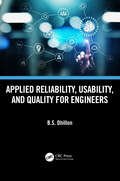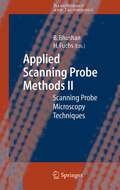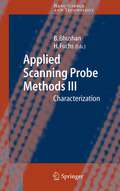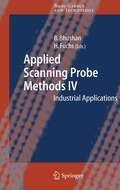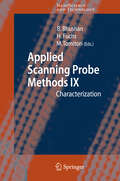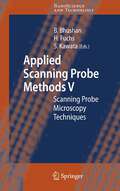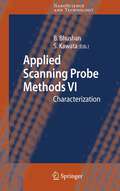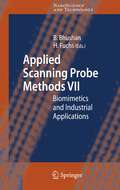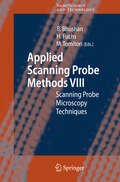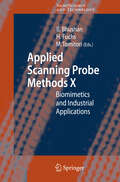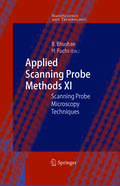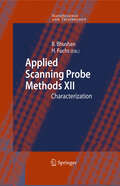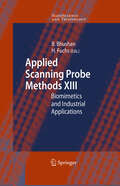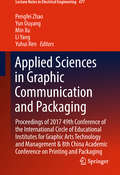- Table View
- List View
Applied Reliability, Usability, and Quality for Engineers
by B.S. DhillonGlobal competition is forcing reliability and other professionals to work closely during the product design and manufacturing phase. Because of this collaboration, reliability, usability, and quality principles are being applied across many diverse sectors of the economy. This book offers the principles, methods, and procedures for these areas in one resource. This book brings together the areas of reliability, usability, and quality for those working in diverse areas to allow them to be exposed to activities that can help them perform their tasks more effectively. This is the only book that covers these areas together in this manner and written in such a way that no previous knowledge is required to understand it. The sources of the material presented are included in the reference section at the end of each chapter along with examples and solutions to test reader comprehension. Applied Reliability, Usability, and Quality for Engineers is useful to design, manufacturing, and systems engineers, as well as manufacturing managers, reliability, usability and, quality specialists. It can also be helpful to graduate, senior undergraduate students, and instructors.
Applied Reliability, Usability, and Quality for Engineers
by B.S. DhillonGlobal competition is forcing reliability and other professionals to work closely during the product design and manufacturing phase. Because of this collaboration, reliability, usability, and quality principles are being applied across many diverse sectors of the economy. This book offers the principles, methods, and procedures for these areas in one resource. This book brings together the areas of reliability, usability, and quality for those working in diverse areas to allow them to be exposed to activities that can help them perform their tasks more effectively. This is the only book that covers these areas together in this manner and written in such a way that no previous knowledge is required to understand it. The sources of the material presented are included in the reference section at the end of each chapter along with examples and solutions to test reader comprehension. Applied Reliability, Usability, and Quality for Engineers is useful to design, manufacturing, and systems engineers, as well as manufacturing managers, reliability, usability and, quality specialists. It can also be helpful to graduate, senior undergraduate students, and instructors.
Applied Research in Hydraulics and Heat Flow
by Kaveh Hariri Asli Soltan Ali AliyevApplied Research in Hydraulics and Heat Flow covers modern subjects of mechanical engineering such as fluid mechanics, heat transfer, and flow control in complex systems as well as new aspects related to mechanical engineering education. The chapters help to enhance the understanding of both the fundamentals of mechanical engineering and their appl
Applied Research in Uncertainty Modeling and Analysis (International Series in Intelligent Technologies #20)
by Bilal M. AyyubThe application areas of uncertainty are numerous and diverse, including all fields of engineering, computer science, systems control and finance. Determining appropriate ways and methods of dealing with uncertainty has been a constant challenge. The theme for this book is better understanding and the application of uncertainty theories. This book, with invited chapters, deals with the uncertainty phenomena in diverse fields. The book is an outgrowth of the Fourth International Symposium on Uncertainty Modeling and Analysis (ISUMA), which was held at the center of Adult Education, College Park, Maryland, in September 2003. All of the chapters have been carefully edited, following a review process in which the editorial committee scrutinized each chapter. The contents of the book are reported in twenty-three chapters, covering more than . . ... pages. This book is divided into six main sections. Part I (Chapters 1-4) presents the philosophical and theoretical foundation of uncertainty, new computational directions in neural networks, and some theoretical foundation of fuzzy systems. Part I1 (Chapters 5-8) reports on biomedical and chemical engineering applications. The sections looks at noise reduction techniques using hidden Markov models, evaluation of biomedical signals using neural networks, and changes in medical image detection using Markov Random Field and Mean Field theory. One of the chapters reports on optimization in chemical engineering processes.
Applied Research on Polymer Composites
by Pooria Pasbakhsh Gennady E. ZaikovThis new volume presents leading-edge research in the rapidly changing and evolving field of polymer science as well as on chemical processing. The topics in the book reflect the diversity of research advances in the production and application of modern polymeric materials and related areas, focusing on the preparation, characterization, and applic
Applied Risk Management in Agriculture
by Dana L. HoagDefining the fundamentals of building a risk management plan, Applied Risk Management in Agriculture uses strategic management to organize the process of risk management. A time-tested procedure inside and outside the business community, this technique provides an ideal platform for organizing risk.Making complex principles easily accessible to stu
Applied RVE Reconstruction and Homogenization of Heterogeneous Materials
by Yves Rémond Said Ahzi Majid Baniassadi Hamid GarmestaniStatistical correlation functions are a well-known class of statistical descriptors that can be used to describe the morphology and the microstructure-properties relationship. A comprehensive study has been performed for the use of these correlation functions for the reconstruction and homogenization in nano-composite materials. Correlation functions are measured from different techniques such as microscopy (SEM or TEM), small angle X-ray scattering (SAXS) and can be generated through Monte Carlo simulations. In this book, different experimental techniques such as SAXS and image processing are presented, which are used to measure two-point correlation function correlation for multi-phase polymer composites. Higher order correlation functions must be calculated or measured to increase the precision of the statistical continuum approach. To achieve this aim, a new approximation methodology is utilized to obtain N-point correlation functions for multiphase heterogeneous materials. The two-point functions measured by different techniques have been exploited to reconstruct the microstructure of heterogeneous media. Statistical continuum theory is used to predict the effective thermal conductivity and elastic modulus of polymer composites. N-point probability functions as statistical descriptors of inclusions have been exploited to solve strong contrast homogenization for effective thermal conductivity and elastic modulus properties of heterogeneous materials. Finally, reconstructed microstructure is used to calculate effective properties and damage modeling of heterogeneous materials.
Applied RVE Reconstruction and Homogenization of Heterogeneous Materials
by Yves Rémond Said Ahzi Majid Baniassadi Hamid GarmestaniStatistical correlation functions are a well-known class of statistical descriptors that can be used to describe the morphology and the microstructure-properties relationship. A comprehensive study has been performed for the use of these correlation functions for the reconstruction and homogenization in nano-composite materials. Correlation functions are measured from different techniques such as microscopy (SEM or TEM), small angle X-ray scattering (SAXS) and can be generated through Monte Carlo simulations. In this book, different experimental techniques such as SAXS and image processing are presented, which are used to measure two-point correlation function correlation for multi-phase polymer composites. Higher order correlation functions must be calculated or measured to increase the precision of the statistical continuum approach. To achieve this aim, a new approximation methodology is utilized to obtain N-point correlation functions for multiphase heterogeneous materials. The two-point functions measured by different techniques have been exploited to reconstruct the microstructure of heterogeneous media. Statistical continuum theory is used to predict the effective thermal conductivity and elastic modulus of polymer composites. N-point probability functions as statistical descriptors of inclusions have been exploited to solve strong contrast homogenization for effective thermal conductivity and elastic modulus properties of heterogeneous materials. Finally, reconstructed microstructure is used to calculate effective properties and damage modeling of heterogeneous materials.
Applied Safety for Engineers: Systems and Products
by B.S. DhillonGlobal competition and other factors are forcing manufacturers to produce highly safe engineering systems and products. This book meets the needs for product designers, systems engineers, and safety engineers that work together and need a single resource which considers all three areas when designing new products and systems that they can refer to. Applied Safety for Engineers: Systems and Products serves as a comprehensive resource offering a wide range of safety topics when involved with product design, engineering system analysis, and engineering maintenance. Examples along with their solutions are placed at the end of each chapter to test reader comprehension. The book facilitates the importance for product designers, safety, and systems engineering professionals to work closely during the product design phase so they can understand each other’s discipline. Written in a manner that readers do not need any previous knowledge on the subject, the book offers many sources for further reading at the end of each chapter. This book will be useful to product designers, system engineers, safety specialists, graduate and senior undergraduate students, researchers and manufacturers, industrial engineers, safety engineers, and engineers-at-large.
Applied Safety for Engineers: Systems and Products
by B.S. DhillonGlobal competition and other factors are forcing manufacturers to produce highly safe engineering systems and products. This book meets the needs for product designers, systems engineers, and safety engineers that work together and need a single resource which considers all three areas when designing new products and systems that they can refer to. Applied Safety for Engineers: Systems and Products serves as a comprehensive resource offering a wide range of safety topics when involved with product design, engineering system analysis, and engineering maintenance. Examples along with their solutions are placed at the end of each chapter to test reader comprehension. The book facilitates the importance for product designers, safety, and systems engineering professionals to work closely during the product design phase so they can understand each other’s discipline. Written in a manner that readers do not need any previous knowledge on the subject, the book offers many sources for further reading at the end of each chapter. This book will be useful to product designers, system engineers, safety specialists, graduate and senior undergraduate students, researchers and manufacturers, industrial engineers, safety engineers, and engineers-at-large.
Applied Scanning Probe Methods I (NanoScience and Technology)
Examining the physical and technical foundation for recent progress with this technique, Applied Scanning Probe Methods offers a timely and comprehensive overview of SPM applications, now that industrial applications span topographic and dynamical surface studies of thin-film semiconductors, polymers, paper, ceramics, and magnetic and biological materials. First it lays the theoretical background of static and dynamic force microscopies, including sensor technology and tip characterization, contributions detail applications such as macro- and nanotribology, polymer surfaces, and roughness investigations. The final part on industrial research addresses special applications of scanning force nanoprobes such as atomic manipulation and surface modification, as well as single electron devices based on SPM.
Applied Scanning Probe Methods II: Scanning Probe Microscopy Techniques (NanoScience and Technology)
by Bharat Bhushan Harald FuchsThe Nobel Prize of 1986 on Sc- ningTunnelingMicroscopysignaled a new era in imaging. The sc- ning probes emerged as a new - strument for imaging with a p- cision suf?cient to delineate single atoms. At ?rst there were two – the Scanning Tunneling Microscope, or STM, and the Atomic Force Mic- scope, or AFM. The STM relies on electrons tunneling between tip and sample whereas the AFM depends on the force acting on the tip when it was placed near the sample. These were quickly followed by the M- netic Force Microscope, MFM, and the Electrostatic Force Microscope, EFM. The MFM will image a single magnetic bit with features as small as 10nm. With the EFM one can monitor the charge of a single electron. Prof. Paul Hansma at Santa Barbara opened the door even wider when he was able to image biological objects in aqueous environments. At this point the sluice gates were opened and a multitude of different instruments appeared. There are signi?cant differences between the Scanning Probe Microscopes or SPM, and others such as the Scanning Electron Microscope or SEM. The probe microscopes do not require preparation of the sample and they operate in ambient atmosphere, whereas, the SEM must operate in a vacuum environment and the sample must be cross-sectioned to expose the proper surface. However, the SEM can record 3D image and movies, features that are not available with the scanning probes.
Applied Scanning Probe Methods III: Characterization (NanoScience and Technology)
by Bharat Bhushan Harald FuchsThe Nobel Prize of 1986 on Sc- ning Tunneling Microscopy sig- led a new era in imaging. The sc- ning probes emerged as a new i- trument for imaging with a pre- sion suf?cient to delineate single atoms. At ?rst there were two – the Scanning Tunneling Microscope, or STM, and the Atomic Force Mic- scope, or AFM. The STM relies on electrons tunneling between tip and sample whereas the AFM depends on the force acting on the tip when it was placed near the sample. These were quickly followed by the - gneticForceMicroscope,MFM,and the Electrostatic Force Microscope, EFM. The MFM will image a single magnetic bit with features as small as 10nm. With the EFM one can monitor the charge of a single electron. Prof. Paul Hansma at Santa Barbara opened the door even wider when he was able to image biological objects in aqueous environments. At this point the sluice gates were opened and a multitude of different instruments appeared. There are signi?cant differences between the Scanning Probe Microscopes or SPM, and others such as the Scanning Electron Microscope or SEM. The probe microscopes do not require preparation of the sample and they operate in ambient atmosphere, whereas, the SEM must operate in a vacuum environment and the sample must be cross-sectioned to expose the proper surface. However, the SEM can record 3D image and movies, features that are not available with the scanning probes.
Applied Scanning Probe Methods IV: Industrial Applications (NanoScience and Technology)
by Bharat Bhushan Harald FuchsApplied Scanning Probe Methods IX: Characterization (NanoScience and Technology)
by Bharat Bhushan Harald Fuchs Masahiko TomitoriThe volumes VIII, IX and X examine the physical and technical foundation for recent progress in applied scanning probe techniques. This is the first book to summarize the state-of-the-art of this technique. The field is progressing so fast that there is a need for a set of volumes every 12 to 18 months to capture latest developments. These volumes constitute a timely and comprehensive overview of SPM applications.
Applied Scanning Probe Methods V: Scanning Probe Microscopy Techniques (NanoScience and Technology)
by Bharat Bhushan Harald Fuchs Satoshi KawataThe volumes V, VI and VII will examine the physical and technical foundation for recent progress in applied scanning probe techniques. These volumes constitute a timely comprehensive overview of SPM applications. This is the first book summarizing the state-of-the-art of this technique. The chapters are written by leading researchers and application scientists from all over the world and from various industries to provide a broader perspective.
Applied Scanning Probe Methods VI: Characterization (NanoScience and Technology)
by Bharat Bhushan Satoshi KawataThe first volume in the series was released in January 2004 and the second to fourth volumes in early 2006. The field is now progressing so fast that there is a need for one volume every 12 to 18 months to capture latest developments. Volume VI presents 10 chapters on a variety of new and emerging techniques and refinements of SPM applications.
Applied Scanning Probe Methods VII: Biomimetics and Industrial Applications (NanoScience and Technology)
by Bharat Bhushan Harald FuchsThe first volume in the series was released in January 2004 and the second to fourth volumes in early 2006. The field is now progressing so fast that there is a need for one volume every 12 to 18 months to capture latest developments. Volume VII presents 9 chapters on a variety of new and emerging techniques and refinements of SPM applications.
Applied Scanning Probe Methods VIII: Scanning Probe Microscopy Techniques (NanoScience and Technology)
by Bharat Bhushan Harald Fuchs Masahiko TomitoriThe volumes VIII, IX and X examine the physical and technical foundation for recent progress in applied scanning probe techniques. This is the first book to summarize the state-of-the-art of this technique. The field is progressing so fast that there is a need for a set of volumes every 12 to 18 months to capture latest developments. These volumes constitute a timely comprehensive overview of SPM applications.
Applied Scanning Probe Methods X: Biomimetics and Industrial Applications (NanoScience and Technology)
by Bharat Bhushan Harald Fuchs Masahiko TomitoriThe volumes VIII, IX and X examine the physical and technical foundation for recent progress in applied scanning probe techniques. This is the first book to summarize the state-of-the-art of this technique. The field is progressing so fast that there is a need for a set of volumes every 12 to 18 months to capture latest developments. These volumes constitute a timely comprehensive overview of SPM applications.
Applied Scanning Probe Methods XI: Scanning Probe Microscopy Techniques (NanoScience and Technology)
by Bharat Bhushan Harald FuchsApplied Scanning Probe Methods XII: Characterization (NanoScience and Technology)
by Bharat Bhushan Harald FuchsCrack initiation and growth are key issues when it comes to the mechanical reliab- ity of microelectronic devices and microelectromechanical systems (MEMS). Es- cially in organic electronics where exible substrates will play a major role these issues will become of utmost importance. It is therefore necessary to develop me- ods which in situ allow the experimental investigation of surface deformation and fracture processes in thin layers at a micro and nanometer scale. While scanning electron microscopy (SEM) might be used it is also associated with some major experimental drawbacks. First of all if polymers are investigated they usually have to be coated with a metal layer due to their commonly non-conductive nature. Additi- ally they might be damaged by the electron beam of the microscope or the vacuum might cause outgasing of solvents or evaporation of water and thus change material properties. Furthermore, for all kinds of materials a considerable amount of expe- mental effort is necessary to build a tensile testing machine that ts into the chamber. Therefore, a very promising alternative to SEM is based on the use of an atomic force microscope (AFM) to observe in situ surface deformation processes during straining of a specimen. First steps towards this goal were shown in the 1990s in [1–4] but none of these approaches truly was a microtensile test with sample thicknesses in the range of micrometers. To the authors’ knowledge, this was shown for the rst time by Hild et al. in [5]. 16.
Applied Scanning Probe Methods XIII: Biomimetics and Industrial Applications (NanoScience and Technology)
by Bharat Bhushan Harald FuchsThe volumes XI, XII and XIII examine the physical and technical foundation for recent progress in applied scanning probe techniques. The first volume came out in January 2004, the second to fourth volumes in early 2006 and the fifth to seventh volumes in late 2006. The field is progressing so fast that there is a need for a set of volumes every 12 to 18 months to capture latest developments. These volumes constitute a timely comprehensive overview of SPM applications. After introducing scanning probe microscopy, including sensor technology and tip characterization, chapters on use in various industrial applications are presented. Industrial applications span topographic and dynamical surface studies of thin-film semiconductors, polymers, paper, ceramics, and magnetic and biological materials. The chapters have been written by leading researchers and application scientists from all over the world and from various industries to provide a broader perspective.
Applied Science: Knowledge, Modernity, and Britain's Public Realm (Science in History)
by null Robert BudFor almost two centuries, the category of 'applied science' was widely taken to be both real and important. Then, its use faded. How could an entire category of science appear and disappear? By taking a longue durée approach to British attitudes across the nineteenth and twentieth centuries, Robert Bud explores the scientific and cultural trends that led to such a dramatic rise and fall. He traces the prospects and consequences that gave the term meaning, from its origins to its heyday as an elixir to cure many of the economic, cultural, and political ills of the UK, eventually overtaken by its competitor, 'technology'. Bud examines how 'applied science' was shaped by educational and research institutions, sociotechnical imaginaries, and political ideologies and explores the extent to which non-scientific lay opinion, mediated by politicians and newspapers, could become a driver in the classification of science.
Applied Sciences in Graphic Communication and Packaging: Proceedings of 2017 49th Conference of the International Circle of Educational Institutes for Graphic Arts Technology and Management & 8th China Academic Conference on Printing and Packaging (Lecture Notes in Electrical Engineering #477)
by Pengfei Zhao Yun Ouyang Min Xu Li Yang Yuhui RenThis book includes a selection of reviewed papers presented at the 49th Conference of the International Circle of Educational Institutes for Graphic Arts Technology and Management & 8th China Academic Conference on Printing and Packaging, which was held on May 14-16, 2017 in Beijing, China. The conference was jointly organized by the Beijing Institute of Graphic Communication, China Academy of Printing Technology, and International Circle of Educational Institutes for Graphic Arts Technology and Management. With eight keynote talks and 200 presented papers on graphic communication and packaging technologies, the event attracted more than 400 scientists. The proceedings cover the latest advances in color science and technology; image processing technology; digital media technology; digital process management technology in packaging; packaging, etc., and will be of interest to university researchers, R&D engineers and graduate students in the graphic arts, packaging, color science, image science, material science, computer science, digital media and network technology.
